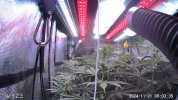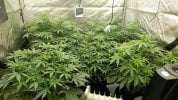I found detailed information at this product page.Thanks mate it's going well! There is 6 sour diesel autoflowers 37 days from sprout in 70/30 coco/perlite. They are loving there new light source you might be interested in doing some research on the light. I got it for 1k aud quite a bit cheaper than retail. Would be interested in your analysis of the light. Fits in a 4×4 but you could set it up in a 5x5 also.
The spectrum appears to have a fair amount of blue based on the spectrum chart. Looking at the chart, I see almost a "dual spike" of red and blue. My preference is for a higher % of red and less blue but there's a reason why people who design grow lights make their choices (I design and write software, not grow lights).

A very different approach is the new Migro spectrum which is getting very high PPFD's and, no surprise, they have a huge amount of red in the spectrum. Is that "juicing" the spectrum? Perhaps, but in terms of yield (and marketing bragging rights) PPFD is the name of the game.

But what threw me is the color chart that revels that the spectrum is 21% red, 75% green, and 4% blue. The spectrum chart certainly does not look like 4% blue but that's the number from the chrono chart.
What does this mean?
The spectral information indicates that this light is oriented toward vegetative growth rather than toward the flowering stage so you will tend to get short, compact plants. There's a lot of green in the spectrum so it will be "easy on the eyes". Humans have excellent green light perception so this light will have a very "daylight" look to it.
The primary driver for crop yield is PPFD. More photons => more photosynthesis => more glucose => more growth => more weed (as long light is the limiting factor). Red diodes deliver more photons for a given input power level and that's why I refer to the Migro spectrum as "when engineering meets marketing". That's somewhat tongue in cheek the bottom line is that red is a way to deliver photons in an electrically efficient manner.
This light doesn't have a lot of red and it also has what I refer to as a "hot spot". Yes, it's a "hot spot" but not a heat hot spot (a "bright spot"?) and it's reminiscent of the hot spot that's inherent to HPS. Lotsa light in the center will a drop of when you move away from center:

The PPFD maps show neither dimensions of the grow area nor the grid size but, assuming that it's a 120cm square, the grids are 20 cm. Most of the PFFD maps I see are 6" grids whereas these are 8". The larger grid size will tend to increase the reported values since the sensor can be placed closer to the center of the light.
Based the map, there's good light in the center 80cm/32" of the grow area so you'll get good growth in plants that are about 40 cm/16" from center mass. The PPFD value in the center of the light is ~1200µmol which is more light than a cannabis plant can use (in ambient CO2). If PPFD is decreased to 900µmol, for example, that's a ~25% decrease in input wattage. That will drop the PPFD about 25% so the 950µmol levels drop to 950 * 0.75≈730µmol. That's a good amount of light but growth yield from a plant at 730 will be about 20% less than a plant at 900µmol (depending on whose research you read). The light in the 20cm strip around the periphery is in DAWA range ("dark as a whale's ass").
As in the good ole days of HPS you can rotate plants into the center and try to even out growth. That's a bit of a pain in the ass, granted.
Supplemental lighting the 660nm range would be money well spent. I'm using the Vipar Spectra Glow R80's but I don't know if they're available in Australia. For me, they were an incremental improvement but, in the case of the Pro Grow, I would argue that they would be a fundamental improvement. The additional PPFD in veg will help with overall growth and the light in the 660nm range will give a good boost in flower. Overall, money well spent.





